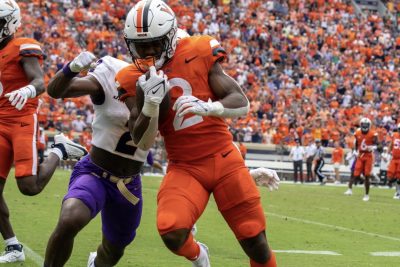Coaches see progress in O-line, running game heading into Maryland
By Jerry Ratcliffe
Virginia has struggled to establish a true, reliable running game for years, and while that is one of the goals of Tony Elliott and offensive coordinator Des Kitchings, the Cavaliers have been lacking in that aspect in the first two games of the season.
Still, Kitchings insists that UVA will be emphasizing the run when the Cavaliers travel to Maryland on Friday (7 p.m., FoxSports1) to renew the old border war between the former rivals.
“We’re not going to abandon [the running game], we’re still going to run the ball because that’s just part of who we are,” Kitchings said after practice on Wednesday. “We’ll take our shots [passing] when they’re there and if we have to drop back and pass, then we’ll do that and clean up our protection issues, but we’re not changing who we are or what we’re doing.”
The problem is that Virginia hasn’t had success running the ball thus far. UVA ranks No. 124 nationally (out of 132 FBS programs) in rushing offense (56.5 yards per game). The Cavaliers’ offensive line has simply been unable to open holes against defenses that have loaded the tackle box in baiting Virginia to throw the ball.
UVA ranks No. 131 in giving up tackles behind the line of scrimmage (21 in two outings) and No. 125 in sacks allowed, even though the Cavaliers often keep the tight end in for pass protection.
Perris Jones bolted to a 75-yard run on the first play from scrimmage against JMU, down to the Dukes’ goal line, but the gain was erased by a holding call. After that, Virginia had few meaningful running plays other than two strong Mike Hollins touchdown runs from 4 and 9 yards out.
Most of the big plays by running backs were pass receptions, 75 yards to Jones, 75 yards to Kobe Pace and another 60-yarder to Jones on a scramble by freshman quarterback Anthony Colandrea.
Virginia is anxious to regain the services of offensive tackle Jimmy Christ, a transfer from Penn State who has been injured since training camp, to boost the line of scrimmage. His status for this week is unknown, but even that addition won’t drastically change UVA’s ability to control the trenches.
“Give the kid credit, he tried to battle back but wasn’t 100 percent last week,” Kitchings said of Christ. “But he’s got another week of prep underneath him. His body is a little bit better from the fall camp injury.”
Tennessee featured a strong front seven and JMU returned several starters from a defense that was No. 2 nationally against the run last season. Maryland also boasts a physical defensive front and will certainly stack the box against Virginia to test quarterback Tony Muskett’s arm.
“JMU, that’s kind of who they are and that’s why I was able to get a bunch of explosive passes in that regard,” Kitchings said of the Dukes’ run defense. “We popped the first [run] for 80 and that would have changed things statistically.
“So there’s no doubt we believe in running the football, and people know that, so [Maryland is] going to try to stack it. We’ve just got to do a better job of protecting, so that when we throw it, we can capitalize on the stack boxes.”
Kitchings said the Terps’ defensive front is built like a typical, physical Big 10 unit.
“They’re pretty stout up front with a 3-4 structure,” Kitchings said. “Their linebackers, the edge guys are 260-plus pounds, linebackers are 230, so they’re built for that Big 10 style. But we believe we have some things we can do to give us an advantage and run the football this week.”
Maryland’s run defense ranks No. 84 nationally (136.5 yards per game), but that’s against Towson and Charlotte. The Terps gave up nearly 200 yards through the air last week against Charlotte, but still rank high nationally in passing yards allowed (158.5, No. 29).
“[Maryland] is kind of similar to James Madison in that they’re going to try to stop the run … that’s their DNA as a program,” Kitchings said. “So that allows maybe some opportunities in the passing game that Charlotte took advantage of. Hopefully we get the same success Friday night.”
The offensive coordinator was encouraged by some of the things he saw in the running game last week, but realizes there is work to do.
“I look at it a couple of different ways,” Kitchings said. “Obviously, statistically, it didn’t show up as being good (18 net yards rushing). But when we were in the red zone, we were 3 for 3 on touchdowns. We had some other runs down in the red zone that kept us on schedule.
“So in that regard, it was very efficient. Now, out in the open field there were some times when it wasn’t as efficient as we’d like, but when I look at the total package, and statistics down’t show it, but in those situations it showed we were effective running the football.”
Elliott realizes the offensive line — which doesn’t have much starting experience — is going through on-the-job training, and that it will take some time.
“I do have hope that these guys are going to put it together because I’ve seen it at times,” Elliott said about the O-line. “What I told the guys during the game and I continue to tell them is, man, when you five guys are on the same page, it’s poetry in motion. It’s a beautiful thing.
“I’ve seen what it can become, so I am very, very hopeful we can put it together. Jimmy Christ coming back off of injury gives us a little bit more depth. We’ve got to get better snapping the ball. We’ve got to be more consistent there. I thought Saturday was better than the previous Saturday, but still not the consistency that we need.”









